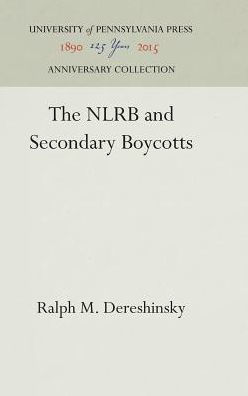The NLRB and Secondary Boycotts
As unions increasingly resort to corporate campaigns, top-down organizing, neutrality agreements, and consumer boycotts, it is easy to forget that federal labor laws were designed to eliminate the causes of substantial obstructions to the free flow of commerce.
Our global economy continually shows that the fortunes of different companies increasingly are interdependent. At the same time, federal labor laws in the U.S. place important restrictions on secondary boycotts—defined as picketing or other union efforts based on one company's dispute to disrupt the affairs of other companies and consumers. Secondary boycotts have played an even more important role in the construction industry, where union disputes often affect dozens of employers working at a single location. Secondary boycotts present among the most complex problems dealt with by U.S. labor laws.
This book examines how federal law limits secondary picketing and comparable activity, while preserving First Amendment free speech rights and protecting primary union activity, even though picketing or pressure directed toward one company almost always affects other parties and people. Ralph M. Dereshinsky looks at the development of labor law, National Labor Relations Board decisions, and court reviews relating to four types of secondary boycott situations. A case-by-case analysis is made to determine the direction and consistency of Board and cournt handling of labor-management disputes over common-situs picketing, allied employer picketing, consumer boycotts, and hot-cargo agreements.
1000767655
Our global economy continually shows that the fortunes of different companies increasingly are interdependent. At the same time, federal labor laws in the U.S. place important restrictions on secondary boycotts—defined as picketing or other union efforts based on one company's dispute to disrupt the affairs of other companies and consumers. Secondary boycotts have played an even more important role in the construction industry, where union disputes often affect dozens of employers working at a single location. Secondary boycotts present among the most complex problems dealt with by U.S. labor laws.
This book examines how federal law limits secondary picketing and comparable activity, while preserving First Amendment free speech rights and protecting primary union activity, even though picketing or pressure directed toward one company almost always affects other parties and people. Ralph M. Dereshinsky looks at the development of labor law, National Labor Relations Board decisions, and court reviews relating to four types of secondary boycott situations. A case-by-case analysis is made to determine the direction and consistency of Board and cournt handling of labor-management disputes over common-situs picketing, allied employer picketing, consumer boycotts, and hot-cargo agreements.
The NLRB and Secondary Boycotts
As unions increasingly resort to corporate campaigns, top-down organizing, neutrality agreements, and consumer boycotts, it is easy to forget that federal labor laws were designed to eliminate the causes of substantial obstructions to the free flow of commerce.
Our global economy continually shows that the fortunes of different companies increasingly are interdependent. At the same time, federal labor laws in the U.S. place important restrictions on secondary boycotts—defined as picketing or other union efforts based on one company's dispute to disrupt the affairs of other companies and consumers. Secondary boycotts have played an even more important role in the construction industry, where union disputes often affect dozens of employers working at a single location. Secondary boycotts present among the most complex problems dealt with by U.S. labor laws.
This book examines how federal law limits secondary picketing and comparable activity, while preserving First Amendment free speech rights and protecting primary union activity, even though picketing or pressure directed toward one company almost always affects other parties and people. Ralph M. Dereshinsky looks at the development of labor law, National Labor Relations Board decisions, and court reviews relating to four types of secondary boycott situations. A case-by-case analysis is made to determine the direction and consistency of Board and cournt handling of labor-management disputes over common-situs picketing, allied employer picketing, consumer boycotts, and hot-cargo agreements.
Our global economy continually shows that the fortunes of different companies increasingly are interdependent. At the same time, federal labor laws in the U.S. place important restrictions on secondary boycotts—defined as picketing or other union efforts based on one company's dispute to disrupt the affairs of other companies and consumers. Secondary boycotts have played an even more important role in the construction industry, where union disputes often affect dozens of employers working at a single location. Secondary boycotts present among the most complex problems dealt with by U.S. labor laws.
This book examines how federal law limits secondary picketing and comparable activity, while preserving First Amendment free speech rights and protecting primary union activity, even though picketing or pressure directed toward one company almost always affects other parties and people. Ralph M. Dereshinsky looks at the development of labor law, National Labor Relations Board decisions, and court reviews relating to four types of secondary boycott situations. A case-by-case analysis is made to determine the direction and consistency of Board and cournt handling of labor-management disputes over common-situs picketing, allied employer picketing, consumer boycotts, and hot-cargo agreements.
95.0
In Stock
5
1

The NLRB and Secondary Boycotts
140
The NLRB and Secondary Boycotts
140Hardcover
$95.00
95.0
In Stock

Product Details
| ISBN-13: | 9780812290752 |
|---|---|
| Publisher: | University of Pennsylvania Press, Inc. |
| Publication date: | 01/29/1972 |
| Series: | Anniversary Collection , #4 |
| Pages: | 140 |
| Product dimensions: | 6.00(w) x 9.00(h) x (d) |
| Age Range: | 18 Years |
About the Author
From the B&N Reads Blog
